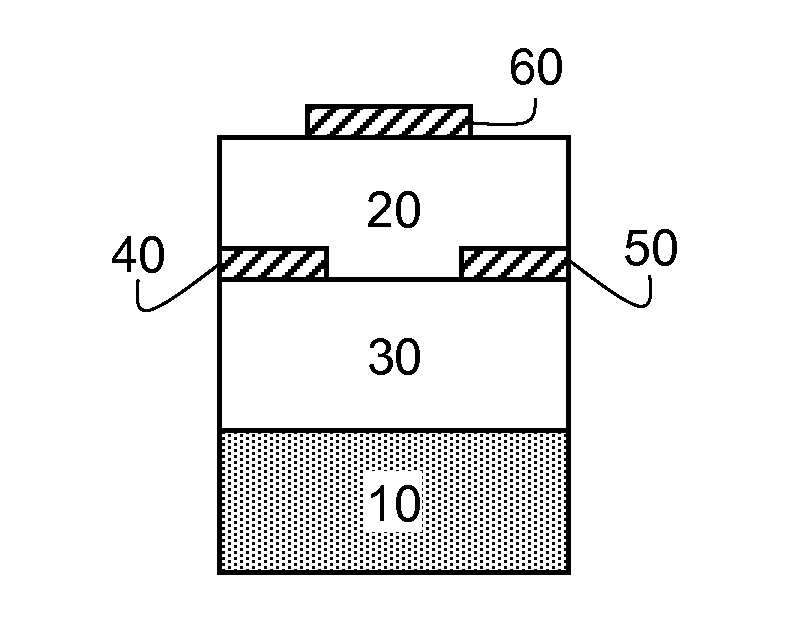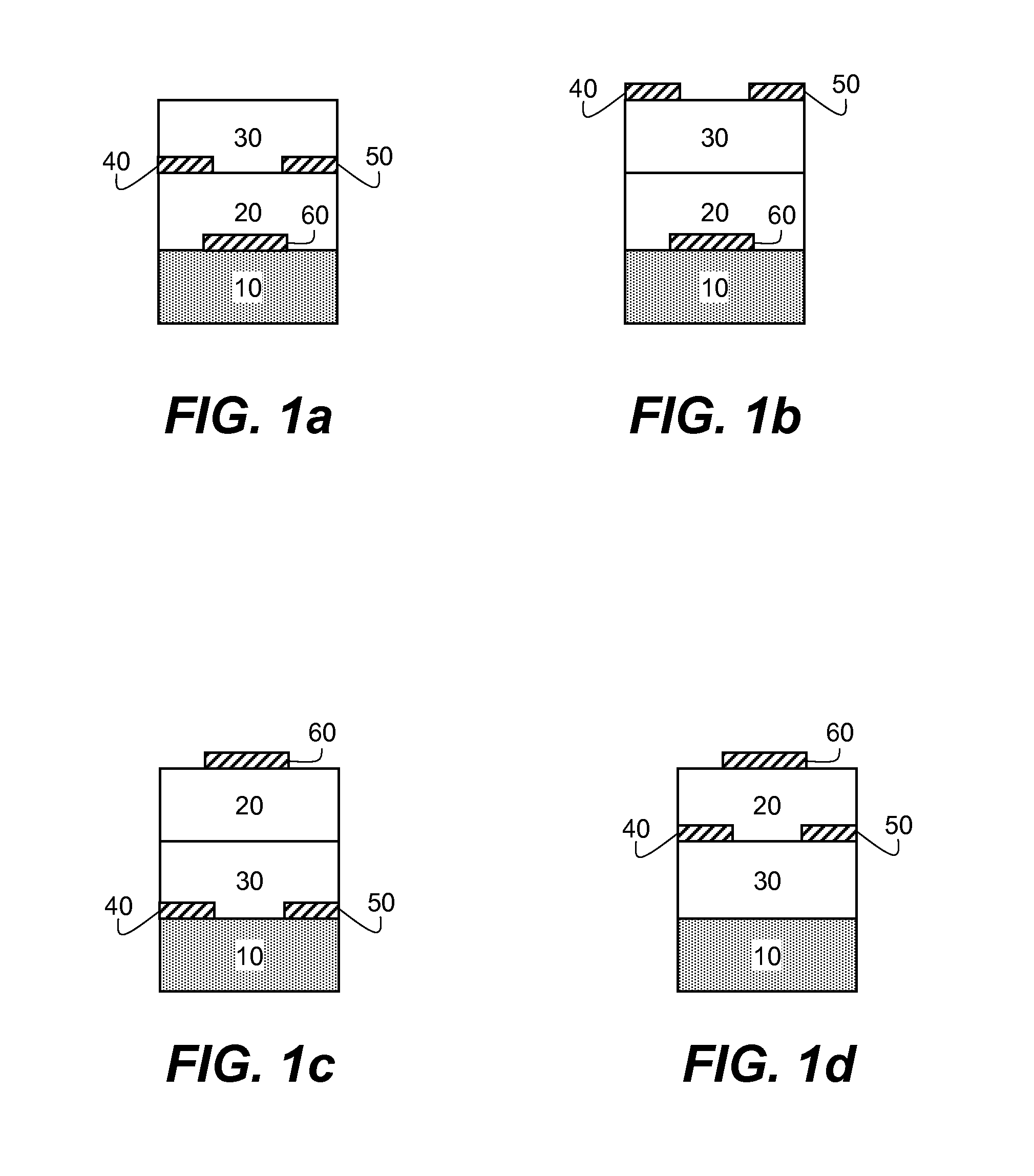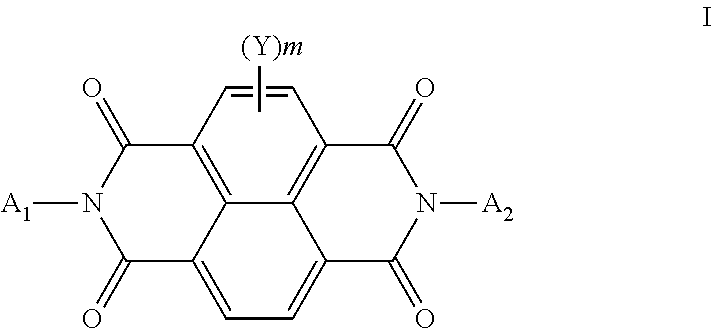Method of making N-type semiconductor devices
a semiconductor and film technology, applied in the direction of solid-state devices, naphthalimide/phthalimide dyes, organic chemistry, etc., can solve the problems of amorphous silicon application limited to low-speed devices, requires relatively costly processes, and achieves enhanced operational stability of ofet devices, better control of semiconductor film morphology, and improved control of thin film morphology
- Summary
- Abstract
- Description
- Claims
- Application Information
AI Technical Summary
Benefits of technology
Problems solved by technology
Method used
Image
Examples
invention example 1
Test Device-2 (Invention Example 1)
[0204]A heavily doped silicon wafer with a thermally-grown SiO2 layer with a thickness of 195 nm was used as the substrate. The wafer was cleaned for 10 minutes in a piranha cleaning solution, followed by a 6-minute exposure in a UV / ozone chamber. An organic semiconducting formulation consisting essentially of N,N′-trans-4-pentylcyclohexyl)-1,4,5,8-naphthodiimide (Compound I-4) (0.5 weight %) and polystyrene (0.5 weight %, Aldrich Chemical Co., average Mw 200,000) in distilled 1,2,4-trimethylbenzene was coated onto silicon dioxide dielectric at 800 RPM for 30 seconds followed by 5000 RPM for 45 seconds. A sample was annealed in air at 100° C. for 1 hour. Subsequently, a gold source and drain electrodes were vapor deposited through a shadow mask to a thickness of 50 nm. The resulting devices had a 650 μm channel width, with channel lengths varying from 50 to 150 μm. Multiple OFET's were prepared and 4 to 12 representative samples were tested for eac...
invention example 2
Test Device 4 (Invention Example 2)
[0212]An organic semiconducting formulation consisting essentially of N,N′-trans-4-pentylcyclohexyl)-1,4,5,8-naphthodiimide (Compound I-4) (0.5 weight %) and polystyrene (0.5 weight %, Aldrich Chemical Co., average Mw 200,000) as the polymer additive in distilled 1,2,4-trimethylbenzene was coated onto the PMMA dielectric layer at 800 RPM for 30 seconds followed by 5000 RPM for 45 seconds. Each sample was annealed in air at 100° C. for 1 hour. Subsequently, a gold source and drain electrodes were vapor deposited through a shadow mask to a thickness of 50 nm. The resulting devices had a 650 μm channel width with channel lengths varying from 50 to 150 μm. Multiple OFET's were prepared and 4 to 12 representative samples were tested for each deposition run. The averaged results appear in TABLE II below.
[0213]The electrical parameters of the devices were measured and calculated as described for Invention Example 1. The average mobility was found to be 0....
invention example 3
Test Device 5 (Invention Example 3)
[0217]An organic semiconducting layer formulation consisting essentially of N,N′-trans-4-pentylcyclohexyl)-1,4,5,8-naphthodiimide (Compound I-4) (0.5 weight %) and Zeonex® RS420 (0.1 weight %) in distilled 1,2,4-trimethylbenzene was coated onto the PMMA dielectric layer at 800 RPM for 30 seconds followed by 5000 RPM for 45 seconds. Each sample was annealed in air at 100° C. for 1 hour. Subsequently, a gold source and drain electrodes were vapor deposited through a shadow mask to a thickness of 50 nm. The resulting devices had a 650 μm channel width with channel lengths varying from 50 to 150 μm. Multiple OFET's were prepared and 4 to 12 representative samples were tested for each deposition run. The averaged results appear in TABLE III below along with the results previously reported for Test Device 3 (Comparative Example 2).
[0218]The electrical parameters of the devices were measured and calculated as described above for Invention Example 1. The a...
PUM
| Property | Measurement | Unit |
|---|---|---|
| electron mobility | aaaaa | aaaaa |
| vacuum energy level | aaaaa | aaaaa |
| electron mobility | aaaaa | aaaaa |
Abstract
Description
Claims
Application Information
 Login to View More
Login to View More - R&D Engineer
- R&D Manager
- IP Professional
- Industry Leading Data Capabilities
- Powerful AI technology
- Patent DNA Extraction
Browse by: Latest US Patents, China's latest patents, Technical Efficacy Thesaurus, Application Domain, Technology Topic, Popular Technical Reports.
© 2024 PatSnap. All rights reserved.Legal|Privacy policy|Modern Slavery Act Transparency Statement|Sitemap|About US| Contact US: help@patsnap.com










